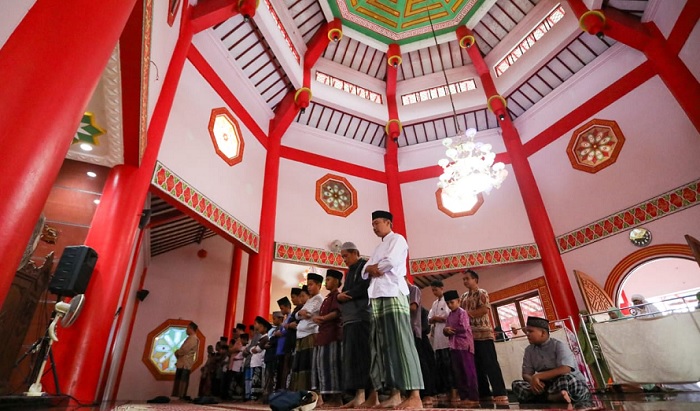The Charm Of Purbalingga's Cheng Hoo Mosque With Oriental Architecture And Ornaments
When you visit Purbalingga, Jawa Tengah, you must see the Muhammad Cheng Ho Mosque located in Selanggeng Village, Mrebet District. This mosque is a popular attraction for religious tourism in the area.
At first glance, the building looks like a temple because it is dominated by red paint with oriental ornaments. It's not surprising that many people think the building is not a mosque. Want to know its uniqueness and philosophy?
The original name of the Cheng Hoo Mosque is Jami' PITI Muhammad Cheng Hoo Mosque. PITI is an acronym for the Indonesian Chinese Islamic Association (PITI).
The building is located on the edge of the Purbalingga-Bobotsari highway, or next to the rest area in the Bobotsari area. For people or tourists who don't know, quite a few think it is not a mosque building. This is because the building is similar to a temple, namely a building for worshiping (praying, worshiping) and carrying out religious ceremonies for Confucian adherents.
According to the Chairman of the PITI Muhammad Cheng Hoo Jami' Mosque Takmir, Mochamad Nur Faizin, residents who rarely cross this road and stop by often don't know that the building is a mosque.
"People who rarely come here know that it's not a mosque, but after seeing the writing of Allah on top, then people think, this means mosque," said Faizin, who met at the mosque, a few days ago, as quoted by jatengprov.go. id.
The color of the mosque building is also dominated by red, the dominant color often found in temple buildings.
Symbol of Courage
Faizin explained that the philosophy of the red color in mosques is courage.
“We must have the courage to make sacrifices. "You have to have the courage to do something, but with a note, do good," he said.
Faizin said that after people found out, many people came to the mosque, especially to pray. Those who were originally curious, now use this place as a stopping place, especially riders. The mosque is open to the public from various circles of Muslims.
He gave a glimpse of the mosque building. The new mosque was inaugurated in 2011. After being built in 2005. Meanwhile, the initiator of the construction of the mosque was a native convert to Islam from Bobotsari, Purbalingga, named Hery Susetyo who is a member of PITI.
Work on the mosque, which had previously stalled, was successfully continued after the participation of the private sector, namely the Savings and Credit Cooperative (Kospin Jasa). Now, the mosque stands strong and majestic.
"The mosque was founded by converts to Islam, so they wanted to build a mosque that was different from the others. Be unique. Maybe the others are in normal shape. "This is the only mosque in Purbalingga which is (you could say) the most unique," he said.
From Takmir's notes, the mosque was originally called the PITI An Naba Mosque. With a building site covering an area of 750 square meters, originating from 560 square meters of waqf land, and land owned by PITI covering an area of 190 square meters. The mosque also changed its name to commemorate the services of a Muslim Chinese sailor, Cheng Hoo.
Based on monitoring at the location, the mosque is often filled with road users who are taking advantage of their rest time to pray. Especially, when it is time for prayer. Not a few of them are happy with the design of this mosque building.
A resident found using the mosque as a place to pray and rest, Ali Roidul Maknun, admitted that he was impressed by the Cheng Hoo Mosque in Purbalingga. He, who was traveling from Cilacap Regency to Batang Regency, often took the time to stop by the mosque.
“If I often pass by here, it is a strategic location. The place can be for praying, it can be for (stopping) to eat, and it can be for resting. The place is delicious and unique. Its uniqueness is in terms of buildings that are different from others which are usually in Middle Eastern style. "This is more Chinese," said Ali. (Aji)

